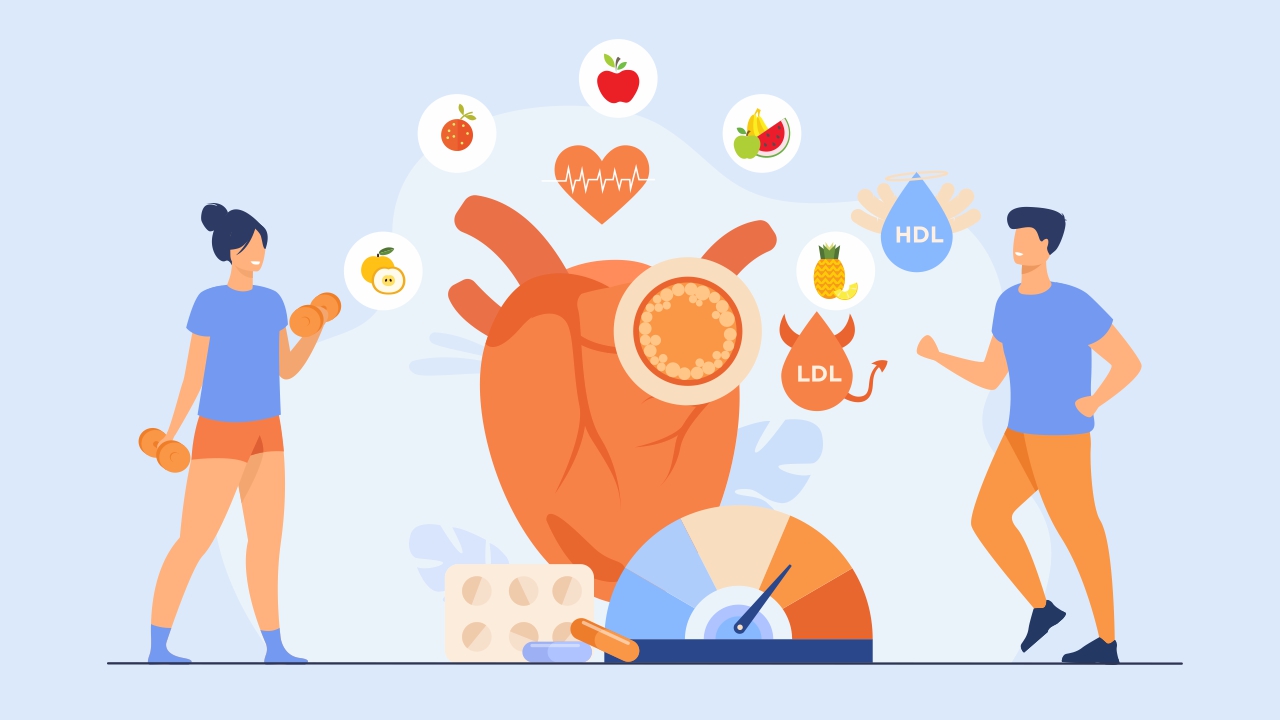
High Cholesterol: How to Combine Nutrition and Exercise to Manage It

Having high blood cholesterol increases the risk of heart disease — a leading cause of death and stroke worldwide. The good news however, is that it is possible to control and manage your cholesterol levels which will lower your risk of heart disease and stroke by following a healthy lifestyle, and adopting simple nutrition and exercise hacks.
But let us first understand what cholesterol exactly is.
What is cholesterol?
Cholesterol (or lipid) is a sticky wax-like substance that circulates in your bloodstream. It is required to carry out important functions, including production of new cells, help in digestion, and absorption of fat soluble vitamins such as A, D, E, and K, as well as production of vitamin D in the skin and for other hormones.
While circulating in the bloodstream, cholesterol is attached to protein molecules acting as a carrier. This combined molecule of fat and protein is called lipoprotein. Cholesterol is further classified as high density lipoprotein (HDL) or “good cholesterol” and low density lipoprotein (LDL) or “bad cholesterol”.
What are good vs bad cholesterol?
| HDL (good cholesterol) | LDL (bad cholesterol) |
|---|---|
| Picks up excess cholesterol from your blood and takes it back to liver | Contributes to fatty build-up in the blood vessel walls (arteries) |
| Excess cholesterol in the liver is broken down and excreted from your body | Accumulation of LDL cholesterol narrows the arteries and increases blood pressure |
| Protects against heart disease | Increases risk of heart attack or stroke |
What are triglycerides?
Triglycerides are the most common type of fat found in your blood. They come from food, as well as made in the body. They store excess energy from your diet. A high triglyceride level combined with high LDL (bad) cholesterol or low HDL (good) cholesterol may contribute to fatty build-up within the artery walls over time.
This fatty buildup or plaque can narrow or completely block the arteries and make them stiffer. This hardening of the arteries requires the heart to make more effort while pumping blood, further increasing the risk of heart attack and stroke.
What is the normal cholesterol range?
Your total cholesterol is a measurement of these three key components of cholesterol.
HDL + LDL + 20% Triglyceride = Total cholesterol
Following are the reference values for adults, according to the 2018 guidelines on the management of blood cholesterol published in the Journal of the American College of Cardiology (JACC).
| Total Cholesterol (mg/dL) | HDL Cholesterol | LDL Cholesterol | Triglycerides | |
|---|---|---|---|---|
| Good | < 200 (but the lower the better) | Ideal is 60 or higher; 40 or higher for men, and 50 or higher for women is acceptable | < 100; below 70, if coronary artery disease is present | < 149; ideal is < 100 |
| Borderline | 200-239 | N/A | 130-159 | 150-199 |
| High | 240 or higher | 60 or higher | 160 or higher | 200 or higher |
| Low | n/a | < 40 | n/a | n/a |
*All values are in mg/dL (milligrams per deciliter) and are based on fasting measurements.
What is cholesterol ratio?
Cholesterol ratio is obtained by dividing your total cholesterol level by your HDL level. For example, if your total cholesterol is 200 and your HDL is 50, your cholesterol ratio is 4. According to American Heart Association, the ideal cholesterol ratio is 3.5. Try to keep it below 5.
What raises your risk for high cholesterol?
1. Health conditions: Diabetes, obesity raises LDL and triglyceride levels and lowers HDL level.
2. Diet high in saturated fat and trans fat: contribute to high cholesterol and related conditions like heart disease.
3. Physical Inactivity: This may lead to weight gain and increased blood cholesterol level
4. Smoking: Damages and hardens your blood vessels. Smoking may also lower your HDL level
5. Alcohol: Excess alcohol intake may raise cholesterol levels and the levels of triglycerides, in the blood
6. Family history: If you have a family history of high cholesterol, you are more likely to have high cholesterol. The risk may increase even more when a family history combines with unhealthy lifestyle choices, which includes eating unhealthy
7. Age and gender- Until around age 55 (or menopause), women tend to have lower LDL levels than men. At any age, men tend to have lower HDL than women do.
So, how to keep your cholesterol numbers in line? It is possible to reduce the risk of heart disease and stroke by following certain lifestyle changes:
Dietary and lifestyle guidelines to manage cholesterol
Eat a variety of foods from all food groups, ensuring that you consume adequate nutrients including complex carbohydrates, quality protein, healthy fats, and essential vitamins and minerals. Avoid having packaged processed foods, and when choose a packaged food, read the labels carefully checking for the trans-fat present in the product.
| Foods to include | Foods to exclude |
|---|---|
| Whole grain cereals and millets like sorghum (jowar), pearl millet (bajra), finger millet (ragi/ nachni), foxtail millet etc. | Bakery products such as biscuits, cookies, bread, cakes, donuts, toasts |
| Pulses and legumes like kidney beans, chickpea, green gram, sprouts etc. | Fried foods like fried lentils, fritters |
| Low fat milk and milk products like curd, buttermilk and paneer | Cream, whole fat milk, ice-cream, chocolates |
| Egg (not more than three whole eggs per week), fish such as mackerel (bangada), salmon, black pomfret, sardines, and chicken (without skin) | Red meat like pork, beef, red mutton, smoked, processed or cured meats, bacon, salami, sausages, fried chicken and fried fish |
| All vegetables and seasonal fruits | Fruit juices and aerated drinks |
| Oils such as canola, olive, peanut, safflower, sesame, nuts and seeds like flax seeds, sunflower seeds, chia seeds, and walnuts *The calorific value of all oils is the same (1g of fat = 9 Kcal of energy). Restrict the quantity to 3tsp (15g) per day. | Salty foods like pickles, canned foods, sauces and ketchup, packaged food Avoid use of margarine, vanaspati, butter Avoid reheating and recycling of oil |
Can regular exercise lower cholesterol?
Exercising regularly is good for everyone, whether you are overweight, trying to reduce cholesterol levels, or are young and healthy. The World health organization (WHO) recommends to engage in regular aerobic exercise of moderate intensity for 150-300 minutes per week. Even an addition of 10 minutes of physical activity may bring substantial improvements in health.
Aerobic exercise: According to the American Heart Association, 150 minutes of moderate intensity aerobic exercise per week is enough to lower cholesterol and reduce high blood pressure.
Walking: Scientists have found that walking for one hour a day five days of the week for 24 weeks increases levels of HDL cholesterol in the body.
Strength training: A 2015 study showed that the levels of HDL cholesterol in the body increased after regular high intensity strength training thrice a week for 10 weeks.
Other sports and activities like swimming, yoga, basketball, football, high intensity interval training may also be beneficial for lowering cholesterol and improving general health. Combination of a healthy diet and regular exercise may help reduce your blood cholesterol remarkably.
Diet and exercise: A combined approach to lower cholesterol
A recent review study reported that exercise, along with a low-saturated fat diet, can reduce LDL cholesterol and triglyceride levels, while increasing HDL cholesterol levels. It’s basically a win-win combination when it comes to heart health.
As dietary approaches tend to lower total cholesterol, LDL cholesterol and triglyceride levels, exercise tends to raise HDL cholesterol levels and lower triglyceride levels. Therefore, it seems sensible to combine these approaches to manage high cholesterol for better health.
References
1. Salim S. Virani, Alvaro Alonso et al. Heart Disease and Stroke Statistics—2020 Update: A Report From the American Heart Association. Circulation. 2020;141:e139–e596.
2. NCD Risk Factor Collaboration (NCD-RisC). Repositioning of the global epicentre of non-optimal cholesterol. Nature 2020 Jun; 582:73.
3. Cholesterol Score – American Heart Association, 2020, “Check. Change. Control. Cholesterol” https://www.heart.org/-/media/files/health-topics/cholesterol/cholesterol-score-explained-english.pdf?la=en.
4. Scott M. Grundy et.al. “2018 AHA/ACC/AACVPR/AAPA/ABC/ACPM/ADA/AGS/APhA/ASPC/NLA/PCNA Guideline on the Management of Blood Cholesterol: A Report of the American College of Cardiology/American Heart Association Task Force on Clinical Practice Guidelines.” Originally published10 Nov 2018https://doi.org/10.1161/CIR.0000000000000625Circulation. 2019;139:e1082–e1143 https://www.ahajournals.org/doi/10.1161/CIR.0000000000000625
5. American Heart Association. “Cholesterol ratio.” Heart-Encyclopedia – cholesterol ratio, https://www.heart.org/HEARTORG/Encyclopedia/Heart-Encyclopedia_UCM_445084_ContentIndex.jsp?title=cholesterol%20ratio.
6. American Heart Association. “Prevention and Treatment of High Cholesterol (Hyperlipidemia).” Written by American Heart Association editorial staff and last Reviewed: Nov 11, 2020 by science and medicine advisers. https://www.heart.org/en/health-topics/cholesterol/prevention-and-treatment-of-high-cholesterol-hyperlipidemia
7. Maeda K, Noguchi Y, Fukui T. The effects of cessation from cigarette smoking on the lipid and lipoprotein profiles: a meta-analysis. Prev Med 2003;37:283290
8. Di Raimondo D, Tuttolomondo A, Buttà C, Casuccio A, Giarrusso L, Miceli G, Licata G, Pinto A. Metabolic and anti-inflammatory effects of a home-based programme of aerobic physical exercise. Int J Clin Pract. 2013 Dec;67(12):1247-53. doi: 10.1111/ijcp.12269. PMID: 24246205.
9. Almenning, I., Rieber-Mohn, A., Lundgren, K. M., Shetelig Løvvik, T., Garnæs, K. K., & Moholdt, T. (2015). Effects of High Intensity Interval Training and Strength Training on Metabolic, Cardiovascular and Hormonal Outcomes in Women with Polycystic Ovary Syndrome: A Pilot Study. PloS one, 10(9), e0138793. https://doi.org/10.1371/journal.pone.0138793
10. Varady KA, Jones PJ. Combination diet and exercise interventions for the treatment of dyslipidemia: an effective preliminary strategy to lower cholesterol levels? J Nutr. 2005;135(8):1829–1835.
11. https://www.who.int/news-room/fact-sheets/detail/physical-activity
12. World Health Organization. Global status report on alcohol and health—2018. Geneva, Switzerland: World Health Organization; 2018.
13. Rehm J, Baliunas D, Borges GL, Graham K, Irving H, Kehoe T, et al. The relation between different dimensions of alcohol consumption and burden of disease: an overview. Addiction. 2010;105(5):817-43.
14. Dietary Approaches for Managing Hyperlipidemia. Erin Scarlett, MPH, RD December 7, 2018
15. <a href=’https://www.freepik.com/vectors/people’>People vector created by pch.vector – www.freepik.com</a>














